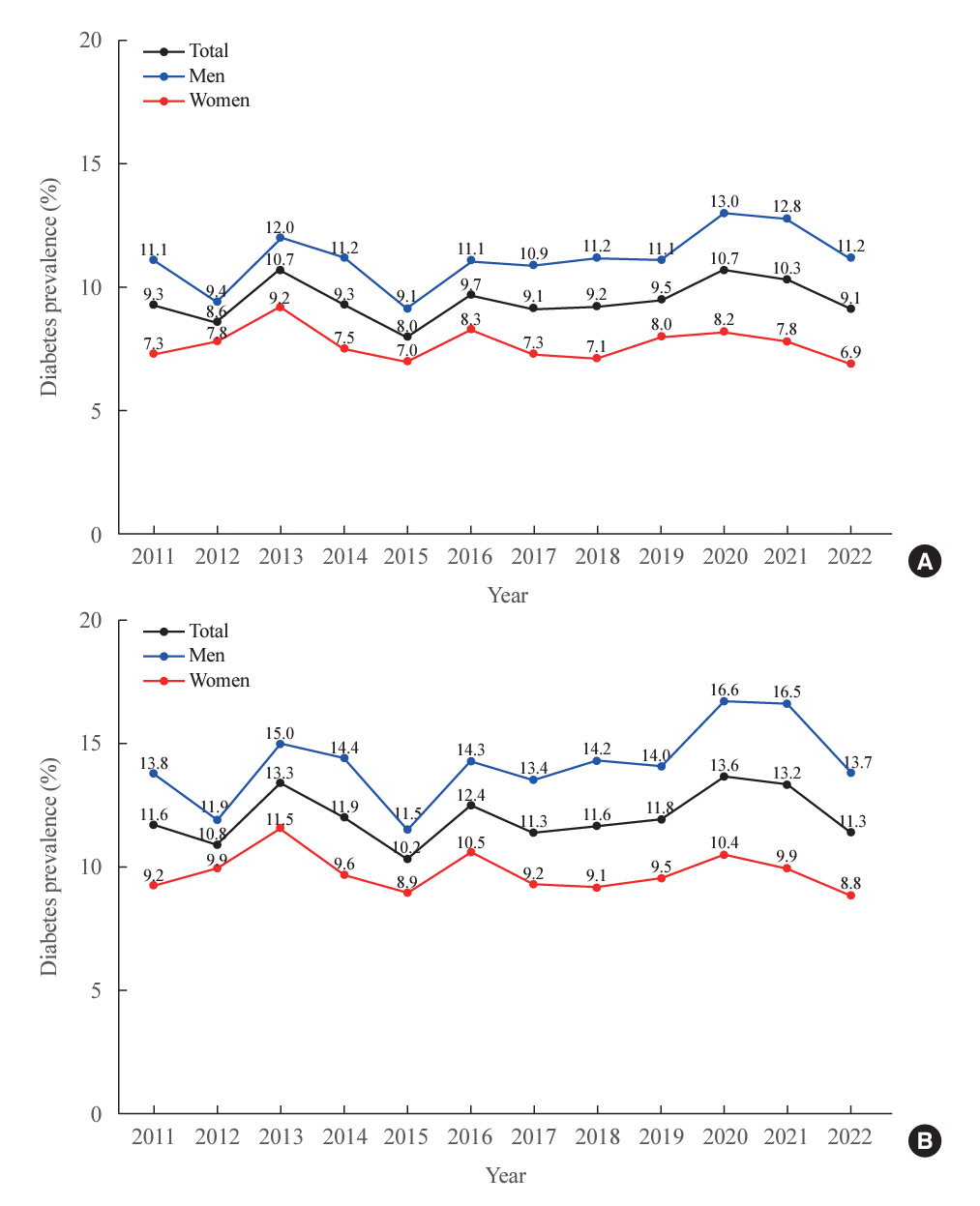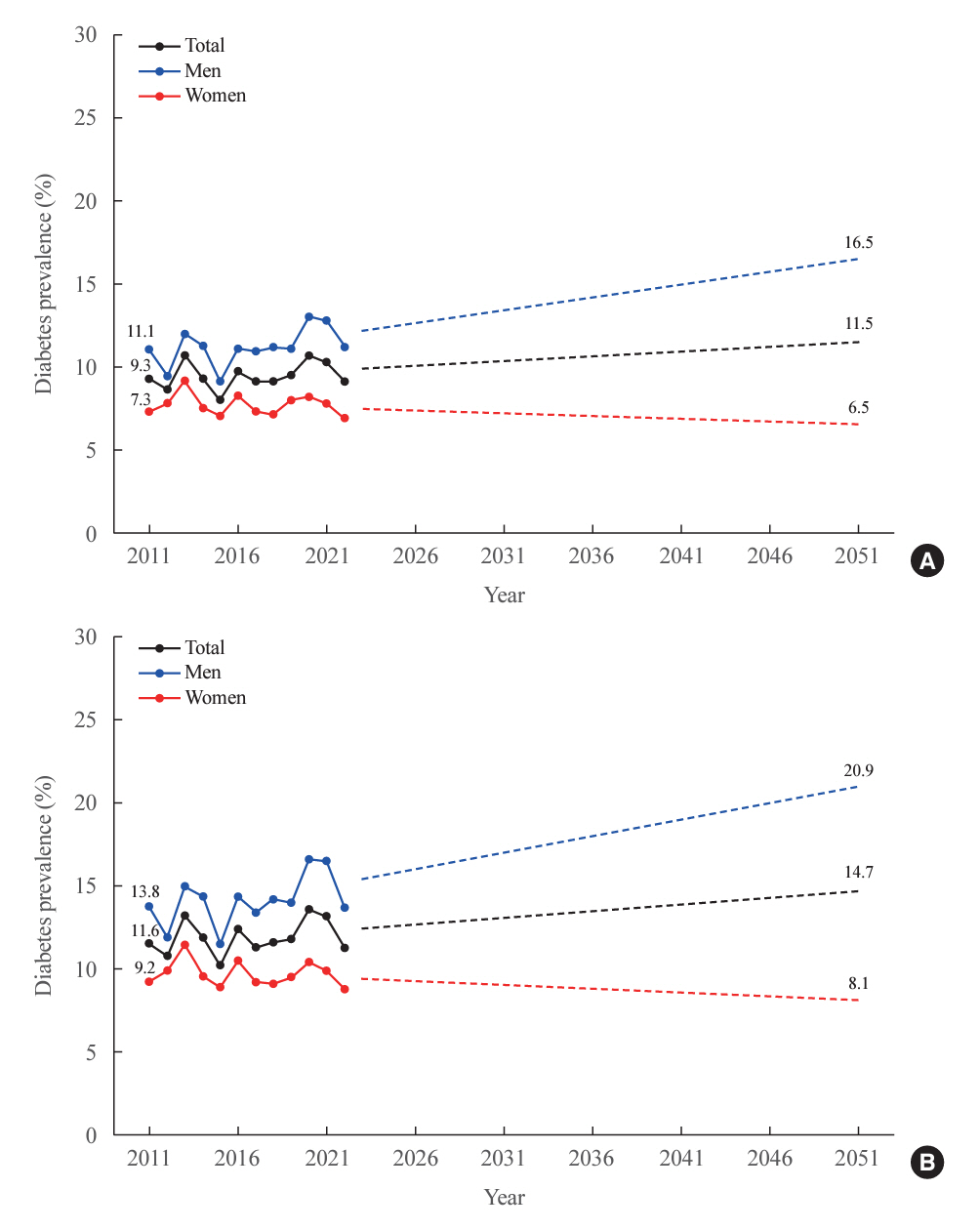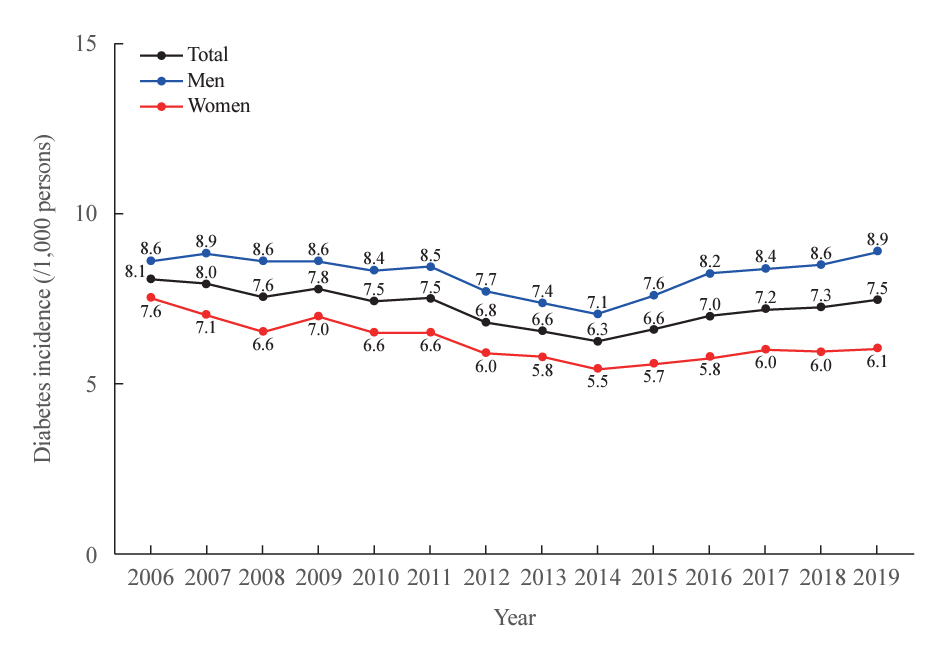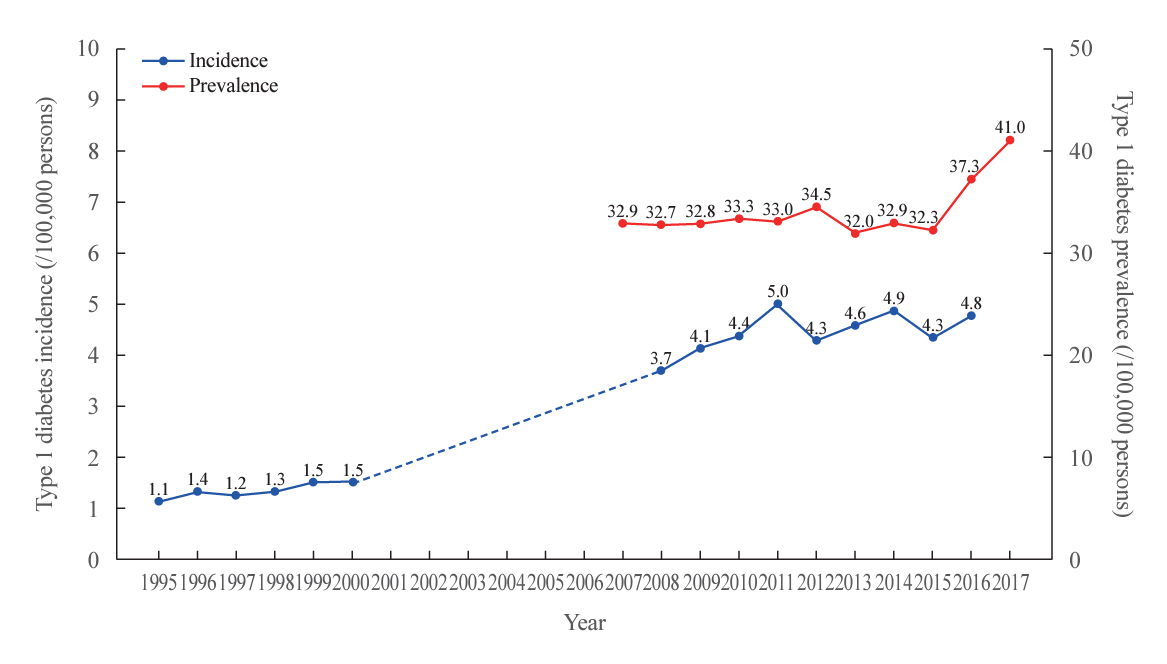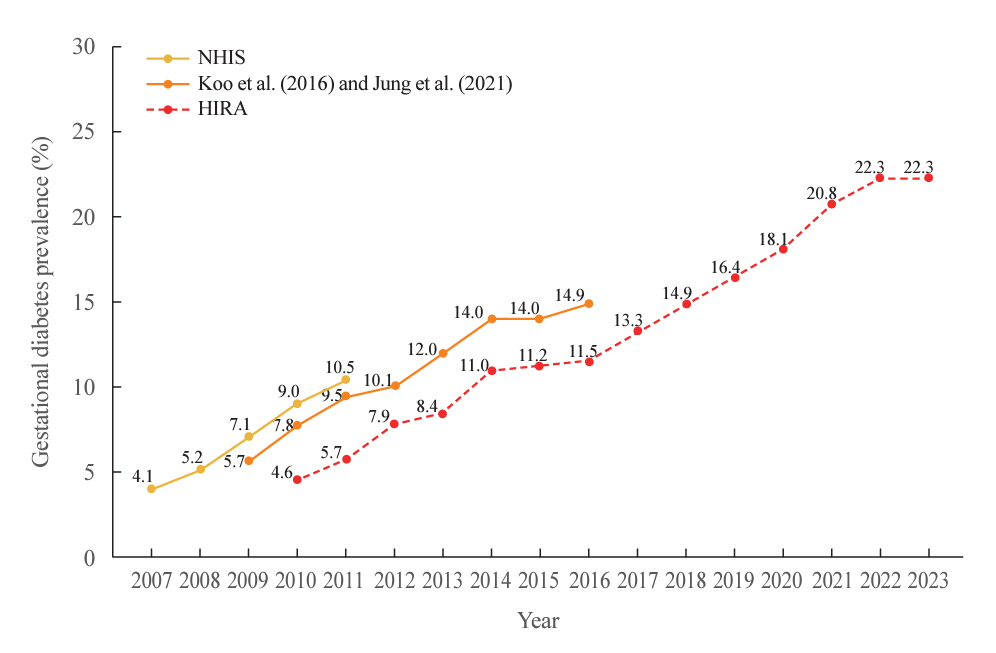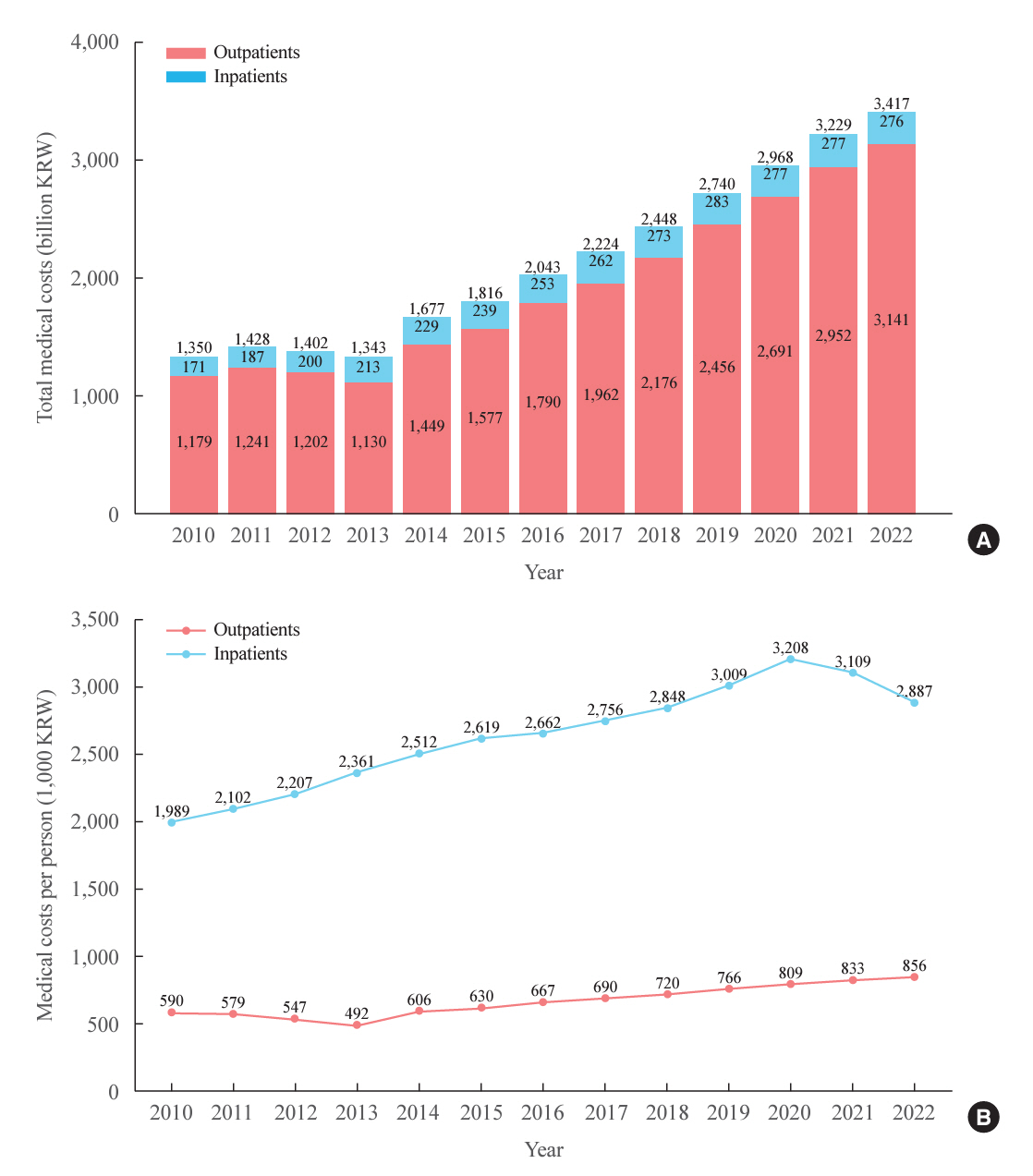Endocrinol Metab.
2024 Oct;39(5):669-677. 10.3803/EnM.2024.2073.
Changes in the Epidemiological Landscape of Diabetes in South Korea: Trends in Prevalence, Incidence, and Healthcare Expenditures
- Affiliations
-
- 1Department of Endocrinology and Metabolism, Ajou University School of Medicine, Suwon, Korea
- KMID: 2560273
- DOI: http://doi.org/10.3803/EnM.2024.2073
Abstract
- Diabetes is a serious public health concern that significantly contributes to the global burden of disease. In Korea, the prevalence of diabetes is 12.5% among individuals aged 19 and older, and 14.8% among individuals aged 30 and older as of 2022. The total number of people with diabetes among those aged 19 and older is estimated to be 5.4 million. The incidence of diabetes decreased from 8.1 per 1,000 persons in 2006 to 6.3 per 1,000 persons in 2014, before rising again to 7.5 per 1,000 persons in 2019. Meanwhile, the incidence of type 1 diabetes increased significantly, from 1.1 per 100,000 persons in 1995 to 4.8 per 100,000 persons in 2016, with the prevalence reaching 41.0 per 100,000 persons in 2017. Additionally, the prevalence of gestational diabetes saw a substantial rise from 4.1% in 2007 to 22.3% in 2023. These changes have resulted in increases in the total medical costs for diabetes, covering both outpatient and inpatient services. Therefore, effective diabetes prevention strategies are urgently needed.
Keyword
Figure
Reference
-
1. Sun H, Saeedi P, Karuranga S, Pinkepank M, Ogurtsova K, Duncan BB, et al. IDF Diabetes Atlas: global, regional and country-level diabetes prevalence estimates for 2021 and projections for 2045. Diabetes Res Clin Pract. 2022; 183:109119.
Article2. Statistics Korea. Korean Statistical Information Service [Internet]. Daejeon: Statistics Korea;2024. [cited 2024 Aug 26]. Available from: https://kosis.kr.3. Lee GB, Kim Y, Park S, Kim HC, Oh K. Obesity, hypertension, diabetes mellitus, and hypercholesterolemia in Korean adults before and during the COVID-19 pandemic: a special report of the 2020 Korea National Health and Nutrition Examination Survey. Epidemiol Health. 2022; 44:e2022041.
Article4. Choi JH, Kim KM, Song K, Seo GH. Risk for newly diagnosed type 2 diabetes mellitus after COVID-19 among Korean adults: a nationwide matched cohort study. Endocrinol Metab (Seoul). 2023; 38:245–52.
Article5. Sinclair A, Saeedi P, Kaundal A, Karuranga S, Malanda B, Williams R. Diabetes and global ageing among 65-99-yearold adults: findings from the International Diabetes Federation Diabetes Atlas, 9th edition. Diabetes Res Clin Pract. 2020; 162:108078.
Article6. Ko SH, Han KD, Park YM, Yun JS, Kim K, Bae JH, et al. Diabetes mellitus in the elderly adults in Korea: based on data from the Korea National Health and Nutrition Examination Survey 2019 to 2020. Diabetes Metab J. 2023; 47:643–52.
Article7. Lee J, Kim HS, Song KH, Yoo SJ, Han K, Lee SH, et al. Risk of cause-specific mortality across glucose spectrum in elderly people: a nationwide population-based cohort study. Endocrinol Metab (Seoul). 2023; 38:525–37.
Article8. Magliano DJ, Chen L, Islam RM, Carstensen B, Gregg EW, Pavkov ME, et al. Trends in the incidence of diagnosed diabetes: a multicountry analysis of aggregate data from 22 million diagnoses in high-income and middle-income settings. Lancet Diabetes Endocrinol. 2021; 9:203–11.
Article9. Choi HH, Choi G, Yoon H, Ha KH, Kim DJ. Rising incidence of diabetes in young adults in South Korea: a national cohort study. Diabetes Metab J. 2022; 46:803–7.
Article10. Magliano DJ, Sacre JW, Harding JL, Gregg EW, Zimmet PZ, Shaw JE. Young-onset type 2 diabetes mellitus: implications for morbidity and mortality. Nat Rev Endocrinol. 2020; 16:321–31.
Article11. Ha KH, Park CY, Jeong IK, Kim HJ, Kim SY, Kim WJ, et al. Clinical characteristics of people with newly diagnosed type 2 diabetes between 2015 and 2016: difference by age and body mass index. Diabetes Metab J. 2018; 42:137–46.
Article12. Ha KH, Lee KA, Han KD, Moon MK, Kim DJ. Diabetes screening in South Korea: a new estimate of the number needed to screen to detect diabetes. Korean J Intern Med. 2023; 38:93–100.
Article13. Lee KA, Kim DJ, Han K, Chon S, Moon MK; Committee of Clinical Practice Guideline of Korean Diabetes Association. Screening for prediabetes and diabetes in Korean nonpregnant adults: a position statement of the Korean Diabetes Association, 2022. Diabetes Metab J. 2022; 46:819–26.
Article14. Holt RI, DeVries JH, Hess-Fischl A, Hirsch IB, Kirkman MS, Klupa T, et al. The management of type 1 diabetes in adults: a consensus report by the American Diabetes Association (ADA) and the European Association for the Study of Diabetes (EASD). Diabetes Care. 2021; 44:2589–625.
Article15. Yu J, Lee SH, Kim MK. Recent updates to clinical practice guidelines for diabetes mellitus. Endocrinol Metab (Seoul). 2022; 37:26–37.
Article16. Ogle GD, James S, Dabelea D, Pihoker C, Svennson J, Maniam J, et al. Global estimates of incidence of type 1 diabetes in children and adolescents: results from the International Diabetes Federation Atlas, 10th edition. Diabetes Res Clin Pract. 2022; 183:109083.
Article17. Shin CH. Epidemiologic characteristics of type 1 diabetes in children aged 14 years or under in Korea, 1985-2000. Korean J Pediatr. 2008; 51:569–75.
Article18. Chae HW, Seo GH, Song K, Choi HS, Suh J, Kwon A, et al. Incidence and prevalence of type 1 diabetes mellitus among Korean children and adolescents between 2007 and 2017: an epidemiologic study based on a national database. Diabetes Metab J. 2020; 44:866–74.
Article19. Korean Ministry of the Interior and Safety. Public Data Portal [Internet]. Sejong: Korean Ministry of the Interior and Safety;2024. [cited 2024 Aug 26]. Available from: https://www.data.go.kr.20. Park J, Kim G, Kim BS, Han KD, Kwon SY, Park SH, et al. Insulin fact sheet in type 1 and 2 diabetes mellitus and trends of antidiabetic medication use in insulin users with type 2 diabetes mellitus: 2002 to 2019. Diabetes Metab J. 2023; 47:211–9.
Article21. International Diabetes Federation. IDF Atlas reports: type 1 diabetes estimates in children and adults. Brussels: IDF;2021.22. Choudhury AA, Devi Rajeswari V. Gestational diabetes mellitus: a metabolic and reproductive disorder. Biomed Pharmacother. 2021; 143:112183.23. HAPO Study Cooperative Research Group, Metzger BE, Lowe LP, Dyer AR, Trimble ER, Chaovarindr U, et al. Hyperglycemia and adverse pregnancy outcomes. N Engl J Med. 2008; 358:1991–2002.
Article24. Wang H, Li N, Chivese T, Werfalli M, Sun H, Yuen L, et al. IDF Diabetes Atlas: estimation of global and regional gestational diabetes mellitus prevalence for 2021 by International Association of Diabetes in Pregnancy Study Group’s Criteria. Diabetes Res Clin Pract. 2022; 183:109050.
Article25. Al-Rifai RH, Abdo NM, Paulo MS, Saha S, Ahmed LA. Prevalence of gestational diabetes mellitus in the Middle East and North Africa, 2000-2019: a systematic review, meta-analysis, and meta-regression. Front Endocrinol (Lausanne). 2021; 12:668447.
Article26. Garmendia ML, Mondschein S, Montiel B, Kusanovic JP. Trends and predictors of gestational diabetes mellitus in Chile. Int J Gynaecol Obstet. 2020; 148:210–8.
Article27. Shah NS, Wang MC, Freaney PM, Perak AM, Carnethon MR, Kandula NR, et al. Trends in gestational diabetes at first live birth by race and ethnicity in the US, 2011-2019. JAMA. 2021; 326:660–9.
Article28. Su FL, Lu MC, Yu SC, Yang CP, Yang CC, Tseng ST, et al. Increasing trend in the prevalence of gestational diabetes mellitus in Taiwan. J Diabetes Investig. 2021; 12:2080–8.
Article29. Tantengco OA, Aquino IM, Asis JL, Tan JJ, Uy MN, Pacheco EP. Research trends in gestational diabetes mellitus in Southeast Asia: a bibliometric analysis (1975-2020). Diabetes Metab Syndr. 2021; 15:102202.
Article30. Jung CH, Jung SH, Choi D, Kim BY, Kim CH, Mok JO. Gestational diabetes in Korea: temporal trends in prevalence, treatment, and short-term consequences from a national health insurance claims database between 2012 and 2016. Diabetes Res Clin Pract. 2021; 171:108586.
Article31. Koo BK, Lee JH, Kim J, Jang EJ, Lee CH. Prevalence of gestational diabetes mellitus in Korea: a national health insurance database study. PLoS One. 2016; 11:e0153107.
Article32. Korean Diabetes Association. Diabetes fact sheet in Korea 2013. Seoul: Korean Diabetes Association;2013.33. Health Insurance Review and Assessment Service. HIRA Bigdata Open portal [Internet]. Wonju: HIRA;2024. [cited 2024 Aug 26]. Available from: https://opendata.hira.or.kr.34. Li Y, Ren X, He L, Li J, Zhang S, Chen W. Maternal age and the risk of gestational diabetes mellitus: a systematic review and meta-analysis of over 120 million participants. Diabetes Res Clin Pract. 2020; 162:108044.
Article35. Cho GJ, Kim LY, Sung YN, Kim JA, Hwang SY, Hong HR, et al. Secular trends of gestational diabetes mellitus and changes in its risk factors. PLoS One. 2015; 10:e0136017.
Article36. Choi MJ, Choi J, Chung CW. Risk and risk factors for postpartum type 2 diabetes mellitus in women with gestational diabetes: a Korean nationwide cohort study. Endocrinol Metab (Seoul). 2022; 37:112–23.
Article37. Korean National Health Insurance Service. Korean National Health Insurance Statistical Yearbook (2010-2022) [Internet]. Wonju: Korean National Health Insurance Service;2024. [cited 2024 Aug 26]. Available from: https://www.nhis.or.kr/nhis/index.do.
- Full Text Links
- Actions
-
Cited
- CITED
-
- Close
- Share
- Similar articles
-
- Prevalence and trends of pain associated with chronic diseases and personal out-of-pocket medical expenditures in Korea
- National Expenditures on Anticancer and Immunomodulating Agents During 2013–2022 in Korea
- Prevalence of Dementia among the South Korean Population
- Hypoglycemia and Health Costs
- Trends in the Incidence, Prevalence, and Mortality of End-Stage Kidney Disease in South Korea

